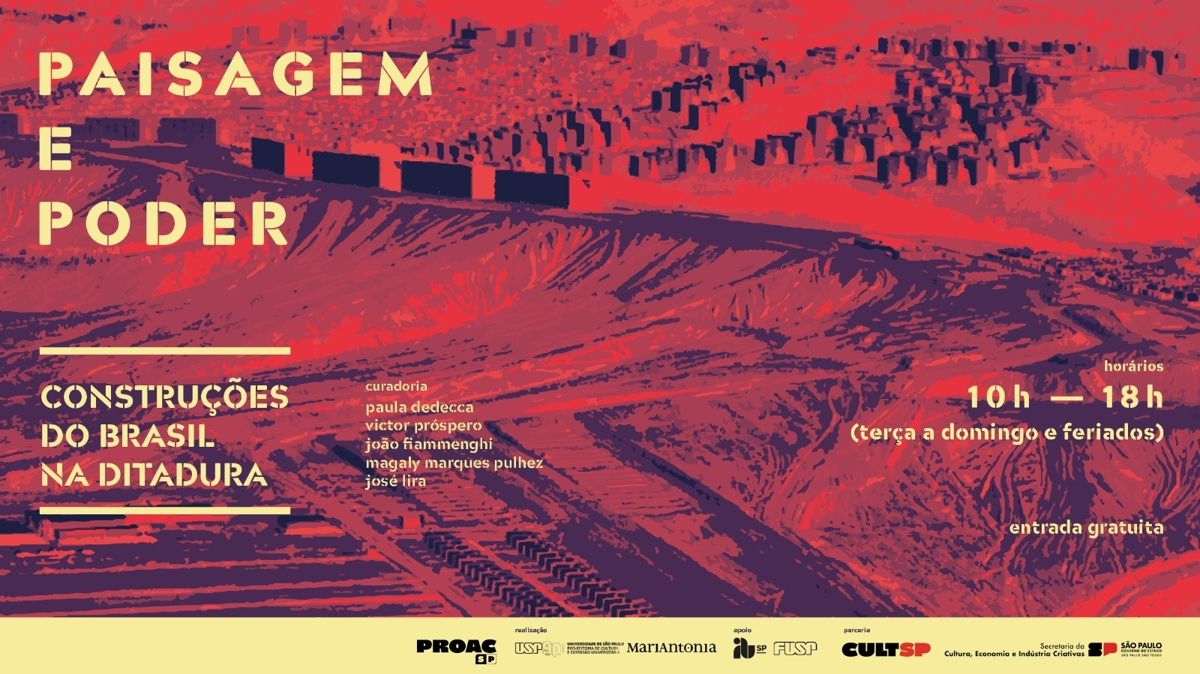Commemorating the 60 years since the 1964 military coup, the Centro MariAntonia presents the exhibition Landscape and Power: constructions of Brazil during the dictatorship, showing the permanence of dictatorship works in the daily space of Brazilian cities.
Text: Sandra Lima
The Centro MariAntonia of USP inaugurates, on March 19, at 7 p.m., the exhibition Landscape and Power: constructions of Brazil during the dictatorship, a documentary exhibition that uses various media and aims to reflect on the built environment during the Brazilian dictatorship period, which lasted 21 years. The curatorial team consists of architects Paula Dedecca, Victor Próspero, João Fiammenghi, Magaly Pulhez, and José Lira. Admission is free.
The exhibition seeks to reflect on the complex and intense transformations of the national territory at its various scales between 1964 and 1985, based on documentation from the time and audiovisual material. According to the curators, much of what we see around us was built during the military regime. The space was profoundly transformed, from residential complexes to the expansion of urban peripheries, from roads and dams built in all corners of the country to viaducts and avenues in the metropolises, from iconic modern buildings to ordinary spatial structures, from the destruction of historical marks to the construction of new cities throughout the national territory. The exhibition aims to present an overview of radical transformations in the Brazilian landscape during that period, reflecting on its contradictions and social and environmental impacts.
Supported by resources from the Cultural Action Program of São Paulo (ProAc) of the Government of the State of São Paulo and the Secretariat of Culture and Creative Economy, the exhibition is based mainly on audiovisual records from the time, such as reports, photographs, films, drawings, and slides, also including documents and technical notebooks from plans of the period. This vast material is the result of research in various Public Archives and institutional and private collections.
The main thematic axes of the exhibition form a journey through territorial dimension plans, extractivist practices, large hydroelectric projects, metropolitan and road infrastructure works, as well as through the massive urbanization process experienced by the capitals throughout the country. The curators understand these axes as intertwined dynamics and testimonies of a fundamental element in the construction and reproduction of that authoritarian regime. The reflection on the built environment in which we live as a document of recent political history adds to the efforts for memory, truth, and justice, adding layers to the understanding of a dark period in the country.
Parallel Program
Until June, there will be a parallel program, free and open to the public:
- Panel discussions on themes related to the exhibition and the historiography of architecture, urbanism, and landscape in the period 1964-1985.
- Cycle of film screenings, followed by debates with the curators and guests.
- Outreach course “Landscape and Power,” taught by the curators.
Who are the curators
Magaly Pulhez is an associate professor at the Federal University of São Paulo (Unifesp). She is an architect and urbanist graduated from the Pontifical Catholic University of Campinas, with a master’s and doctorate in Theory and History of Architecture and Urbanism from the University of São Paulo (USP). She is an associate researcher at the Center for Metropolitan Studies (CEM/CEPID/FAPESP), where she completed a postdoctoral fellowship on state institutions and bureaucracies that operate housing policy in São Paulo, funded by FAPESP. She leads the research group Transborda – Critical Urbanization Studies (CNPq/Unifesp), and has organized the editing and publication of scientific journals and books.
Paula Dedecca is a professor of History of Architecture at the School Association of the City (AEC-SP). She is an architect and urbanist from the Faculty of Architecture and Urbanism (FAU) of USP, with a master’s and doctorate from the same institution. She is the author of articles and book chapters that discuss the professional field and the critique of architecture and urbanism in Brazil from its institutions and its interlocutions with the State and civil society from the 1950s to the 1970s.
Victor Próspero is an architect and urbanist from FAU-USP, with a doctorate from the same institution, supported by FAPESP, focusing on the relationships between the professional field of architecture and the military regime. He was a Fulbright visiting researcher at Harvard University. He is currently a professor at the Mauá Institute of Technology, collaborates with collectives in the Bixiga neighborhood for the preservation of cultural and environmental heritage, and is the 2nd Vice President of the Institute of Architects of Brazil in São Paulo.
João Fiammenghi is an architect and urbanist from FAU-USP. He is currently pursuing his doctorate in the area of History and Foundations of Architecture and Urbanism at FAU-USP with the support of FAPESP.
José Lira is a full professor at FAU-USP and director of the Centro MariAntonia at USP. He was a visiting professor at Princeton University (2022/2023). He holds a degree in Architecture and Urbanism from the Federal University of Pernambuco (UFPE) and in Philosophy from USP, a doctorate from FAU-USP and is a free-docent from the same institution. He carried out postdoctoral research at the Graduate School of Architecture, Planning and Preservation at Columbia University (USA) and, in 2015, at the École Nationale Supérieure d’Architecture de Paris-Malaquais (France). He directed, between 2010 and 2014, the Center for Cultural Preservation of the University of São Paulo (CPC-USP), working on various projects and programs of University Culture and Extension, in the areas of culture, cultural heritage, memory, collections, and university museums. He was a research fellow in Research Productivity from CNPq between 1999 and 2014. His research focuses on the areas of history, historiography, and critique of architecture and urbanism, with emphasis on the relationships between disciplinary discourse and professional practice, conditions of specialized production, and the cultural field and social thought in Brazil; architecture, gender, and sexuality. He is an ad-hoc consultant for CNPq and FAPESP, editor of the Brazilian Journal of Urban and Regional Studies, of Anpur, edited the CPC Journal and is a member of the editorial board of the journals Risco (IAU-USP) and Redobra (UFBA). He is the author and editor of books.
Service
Exhibition Landscape and Power: constructions of Brazil during the dictatorship
Opening on March 19 – starting at 7 p.m.
Where | Centro MariAntonia – Joaquim Nabuco Building
258 Maria Antônia Street – Vila Buarque – São Paulo, SP (near Higienópolis and Santa Cecília metro stations)
When | From March 19 to June 30, 2024
Visiting hours | Tuesday to Sunday, and holidays, from 10 a.m. to 6 p.m.
Cost | Free
Information | (11) 3123-5202″





